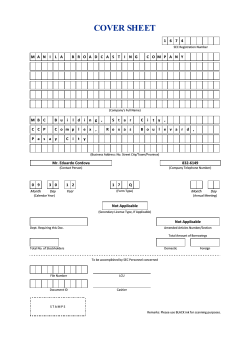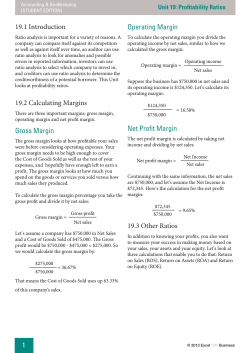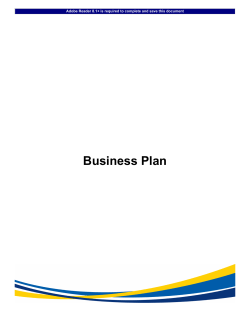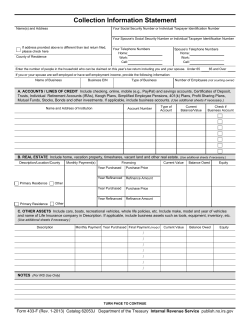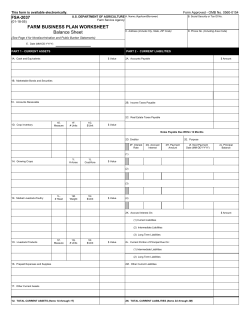
CULTIVATE LIFE COACHING Business Planning for Creative Spirits FINANCIAL WORKSHEETS
CULTIVATE LIFE COACHING Business Planning for Creative Spirits FINANCIAL WORKSHEETS Are you ready to begin collecting figures? Yes you are! Use the worksheets that follow to compile the numbers. You will probably be revising the numbers many times before you complete the process as you become more aware and move deeper into researching your business. No worries, just keep your workbook handy to jot down changes and ideas as they come through. • You can re-create these forms in any spreadsheet program and I have also provided an extra set of financial worksheets in Chapter 8 that you can use to make copies. Business Planning for Creative Spirits ©2002 Start-up Costs (Example) Deposits, Prepayments, Licenses Security deposit on business location Telephone & utility deposits Business Licenses (state, city/town, health & fire) Insurance Premiums (liability, worker’s comp.) Legal, accounting, education _____________ _____________ _____________ _____________ _____________ Leasehold Improvements Remodeling & redecorating (price out down to the cost of the nails) Fixtures, office furniture, displays Installation Labor (make sure contractors are licensed & insured) Signs (outside & inside) _____________ _____________ _____________ _____________ Radio, TV, newspaper, flyers, Yellow Pages _____________ Office Supplies (even pens & staples) Office Equipment (computer, copier, phones, fax) Opening Merchandise or raw material _____________ _____________ _____________ Vehicles Manufacturing equipment Hand tools _____________ _____________ _____________ _____________ Advertising Inventory Other Sub Total Living Expenses (This section needs to be completed only if you will be leaving your present job to open the business.) Living expenses from last paycheck to opening day Mortgage/Rent _____________ Utilities _____________ Credit cards and other loans _____________ Food/personal supplies _____________ Health Insurance _____________ Child costs (daycare, school activities, clothes, braces, doctors) _____________ Alimony and/or child support _____________ Gas for car(s) _____________ Medicine _____________ Living expenses for first three months after opening day Mortgage/Rent _____________ Utilities _____________ Credit cards and other loans _____________ Food/personal supplies _____________ Health Insurance _____________ Child costs (daycare, school activities, clothes, braces, doctors) _____________ Alimony and/or child support _____________ Gas for car(s) _____________ Medicine _____________ Moving Expenses if necessary _____________ Sub Total _____________ Business Operating expenses for three months (fixed costs) _____________ Reserve to carry customer’s accounts (if necessary) _____________ Cash for petty cash and change _____________ Sub Total _____________ Total Start-up Costs Business Planning for Creative Spirits ©2002 ___________ Break Even Analysis (Example) The purpose of this calculation is to determine the minimum sales that are necessary to stay in business. When the business breaks-even, you are not making any profit but you can pay all of your bills, including yourself. There is a blank form on the next page to enter your numbers. Fixed Costs These costs do not vary significantly regardless of the sales volume. Use monthly figures for these costs. Wages (Include yourself) Taxes (About 15% of wages and sales taxes on materials purchased) Indirect Expenses (Rent, utilities, phones, insurance, business taxes and licenses) Advertising (If you don’t budget your advertising monthly, include this in Indirect Expenses) Debt Service(Principal and interest on all loans used to start the business) Total Fixed Costs $2,000.00 $300.00 $1,200.00 $100.00 $600.00 $4,200.00 Per month Gross Margin Gross Margin is the difference between the sales collected for that product/service and the price that the business pays to produce the product/service. Product Example You buy or manufacture a widget that costs $18 to produce (materials & labor). You sell the widget for $40. Selling price Cost per widget $40.00 $18.00 Gross Margin $22.00 Now you need to turn the $22.00 into a percentage figure. Divide the Gross Margin by the Selling Price. 22/40 = .55 or 55% Service Example You write, produce art or clean houses. You need to buy paper, art supplies, or cleaning supplies. You determine the price per hour you charge and add it to your supply costs. In this case it costs $50 per hour. You charge $75 per hour. Selling price Cost per hour $75.00 $50.00 Gross Margin $25.00 Turn the $25.00 into a percentage figure. Divide the Gross Margin by the Selling Price. 25/75 = .33 or 33% Break-Even Formula Using the product example: Fixed Costs divided by Gross Margin = Sales needed to break-even $4,200.00/0.55 = $7,636.36 in monthly sales to break-even If you can adjust some of the fixed costs (increase or decrease wages), or the gross margin (raise or lower prices), the amount of Sales needed to break-even will vary. Business Planning for Creative Spirits ©2002 Business Balance Sheet (Example) Year One Year Two Year Five Current Assets Cash Accounts Receivable Inventory (Includes checking & savings accounts) (Money owed to the business) (Products or materials to be sold) Fixed Assets Real Estate (Do you own the business building or land?) Fixtures & Equipment (Computers, Office Furniture, Manufacturing Machines) Vehicles (Company cars and trucks) Other Assets License Goodwill (trademarks, patents) (Reputation) Total Assets $ Current Liabilities Notes Payable (Due within one year) Accounts Payable(Money owed for materials, indirect costs, labor) __________ Accrued Expenses (Money owed from previous months or years) Taxes Owed (Personal Property, Payroll, Corporate) Long-Term Liabilities Notes Payable Other (Due after one year) Total Liabilities Net Worth (Assets minus liabilities) Business Planning for Creative Spirits ©2002 $ $ __________ ________ Personal Financial Statement (Example) Assets Cash (Includes checking accounts) ____________ Savings Accounts _______________ Stocks, Bonds (Include savings bonds and other securities) _______________ Accounts Receivable (Money owed to you) _______________ Notes Receivable (Loans you made) _______________ ____________ Life Insurance (Cash value) Rebates/Refunds (Overpaid taxes) ____________ Automobiles (And other vehicles) ____________ Real Estate (Your house, property or other buildings) _______________ Vested Pension Plan (Retirement accounts, Social Security) _______________ Other Assets (Jewelry, musical instruments, art work, antiques, furniture)_______________ Total Assets $ ______________ Liabilities Notes Payable Accounts Payable Taxes Payable Real Estate Loans Other Liabilities (Due within one year) (Credit cards, doctors, dentists) (Income taxes, real estate taxes, property taxes) (Your house, any property or other buildings) _______________ _______________ _______________ _______________ _______________ Long-Term Liabilities Notes Payable Other (Due after one year) _______________ _______________ Total Liabilities Net Worth (Assets minus liabilities) Business Planning for Creative Spirits ©2002 $ _______________ $____________ Cash Flow Forecast – Year One Pre-Start Month Receipts Cash sales Collections from credit sales New equity inflow Loans received Other Total Receipts Payments Cash purchases Payments to creditors Salaries and wages Employee benefits Payroll taxes Rent Utilities Repairs and maintenance Insurance Travel Telephone Postage Office supplies Marketing and advertising Professional fees Training and development Bank charges Miscellaneous Owner's draw Loan repayments Tax payments Capital purchases Other – database and Web site Total Payments Cash flow Surplus/Deficit (-) Opening Cash Balance Closing Cash Balance 1 2 3 4 5 6 7 8 9 10 11 12 Totals Cash Flow Forecast – Year Two Pre-Start Month Receipts Cash sales Collections from credit sales New equity inflow Loans received Other Total Receipts Payments Cash purchases Payments to creditors Salaries and wages Employee benefits Payroll taxes Rent Utilities Repairs and maintenance Insurance Travel Telephone Postage Office supplies Marketing and advertising Professional fees Training and development Bank charges Miscellaneous Owner's draw Loan repayments Tax payments Capital purchases Other – database and Web site Total Payments Cash flow Surplus/Deficit (-) Opening Cash Balance Closing Cash Balance Business Planning for Creative Spirits ©2002 1 2 3 4 5 6 7 8 9 10 11 12 Totals Projected Profit & Loss Statement Year 1 Sales Sales Other Total Sales Less Cost of Goods Sold Materials Labor Overhead Other Total Cost of Goods Sold Gross Profit Operating Expenses Salaries and wages Employee benefits Payroll taxes Rent Utilities Repairs and maintenance Insurance Travel Telephone Postage Office supplies Marketing and advertising Professional fees Training and development Bank charges Depreciation Miscellaneous Other Total Operating Expenses Operating Income Interest income (expense) Other income (expense) Total Non Operating Income (Expense) Income (Loss) Before Taxes Income Taxes Net Income (Loss) Cumulative Net Income (Loss) Business Planning for Creative Spirits ©2002 Year 2 Year 5 Totals Summary of Key Ratios - Years 1 to 5 (Example) Year 1 Year 2 Year 3 Year 4 Year 5 DATA COLLECTION Balance Sheet (1) (2) (3) (4) Cash Marketable securities Accounts receivable, net Total current assets ______ ______ ______ ______ ______ ______ ______ ______ ______ ______ ____ __ ______ ______ ______ ______ ______ ______ ______ ______ ______ ______ ______ ______ ______ ______ ______ ______ ______ ______ ______ ______ ______ ______ ______ __ ____ ______ ______ ______ ______ ______ ______ ______ ______ ______ ______ ______ ______ ______ ______ ______ ______ ______ _______ ______ _______ ______ _______ ______ _______ ______ ______ ______ ______ ______ ______ (5) Total long-term assets (6) Total current liabilities (7) Total long-term liabilities (8) Total shareholders' equity Income Statement (9) (10) (11) (12) (13) Total sales Gross profit Total operating expenses Income (loss) before taxes Net income (loss) KEY RATIOS Profitability Ratios Return on equity – Line 13/Line 8 Return on assets – Line 13/(Lines 5 + 6) Return on sales – Line 13/Line 9 Gross profit margin – Line 10/Line 9 Asset turnover ratio – Line 9/(Lines 5 + 6) 0% 0% 0% 0% 0% 0% 0% 0% 0% 0% 0% 0% 0% 0% 0% 0% 0% 0% 0% 0% 0% 0% 0% 0% 0% 0 0% 0% 0 0 0 0% 0% 0 0 0 0% 0% 0 0 0 0% 0% 0 0 0 0% 0% 0 0 Leverage and Liquidity Ratios Current ratio – Line 4/Line 6 Quick or acid test ratio – (Lines 1 + 2 + 3)/Line 6 Leverage ratio - (Lines 4 + 5)/Line 8 Long-term debt ratio – Line 7/(Lines 7 + 8) Debt to equity ratio – (Lines 6 + 7)/Line 8 Business Planning for Creative Spirits ©2002
© Copyright 2025




